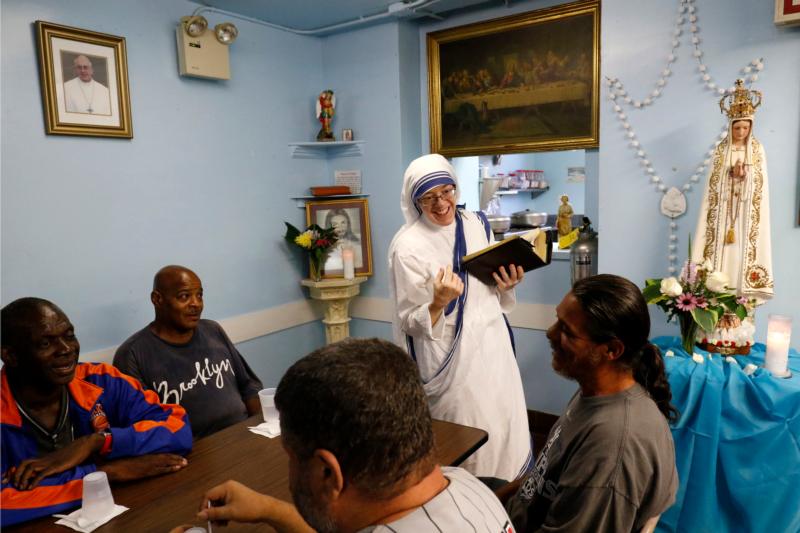
Sister Mary Marta, a member of the Missionaries of Charity, chats with guests after reading from the Bible in a soup kitchen run by her order in an apartment building in the South Bronx section of New York Aug. 24, 2016. Whether we pray the Scriptures in the liturgy or in the privacy of our homes, we are performing an act of worship. (CNS photo/Gregory A. Shemitz)
In a recent address, Pope Francis noted that liturgical education is an unending process. Pope Francis reminds us that liturgical fruitfulness is not merely a matter of participating in the Sunday Mass, but attuning ourselves to pray fruitfully.
It is necessary for us to learn to pray the Mass so that we discover that “the worship of God in our lives cannot be relegated to something private and individual, but tends by its nature to permeate every aspect of our existence,” as Pope Benedict XVI wrote in “Sacramentum Caritatis” (No. 71). How can we approach the Mass, open to learning to practice a eucharistic life?
Getting more out of Mass begins with immersing ourselves in the story of salvation. The Bible is not a textbook of moral behavior. Instead, the Scriptures provide an encounter with the living God mediated through human speech.
[hotblock]
As the Dogmatic Constitution on Divine Revelation notes, “The church has always venerated the divine Scriptures just as she venerates the body of the Lord, since, especially in the sacred liturgy, she unceasingly receives and offers to the faithful the bread of life from the table both of God’s word and of Christ’s body” (No. 21). Whether we pray the Scriptures in the liturgy or in the privacy of our homes, we are performing an act of worship.
This immersion into the Scriptures is not reducible to reading the Bible cover to cover. It is learning a way of reading grounded in the four senses of the Scriptures: the literal, allegorical, moral and anagogical.
The literal sense of the Scriptures relates both to the background of the text, while also attending to each and every word of the Bible. The literal sense opens up the reader to an awareness of God’s activity in history. The Bible is a historical book, showing how the God of Abraham, of Isaac and of Jacob became involved in time and space.
Still, the Scriptures are not just about what God did once upon a time. They’re also about what God is still doing. Reading the Scriptures allegorically makes us aware of the coherency of the scriptural narrative.
The Old and New Testament are not different stories. They’re the same story in which God’s self-emptying love is fulfilled in the life, death and resurrection of Jesus Christ.
[tower]
In the moral sense, we perceive the words of the Scriptures as immersing us into the history of this narrative — our lives are a rich space for the Word to enflesh itself once again.
The anagogical sense leads us to desire anew God’s final action in history.
Preparation for Mass requires us to read the Scriptures in these various ways. We must know about what happens at Christmas in the Scriptures. We must see the birth narratives as a fulfillment of the great prophecies promised in the Old Testament.
We must gaze with wonder at the humility of the infant in the manger, seeing how we too are called to empty ourselves in love. And we are to long for the entire created order to be transformed into Bethlehem, surrounded by the Holy Family, adoring in wondrous silence the infant who created the world.
Entering into the senses of the Scriptures attunes us to long for God to act here and now — just as God does at every Mass.
The Mass is the memorial of Christ’s sacrifice, where our crucified and resurrected Lord becomes present among us. We eat his body and drink his blood, becoming what we have received. But Jesus Christ isn’t the only one offered upon the altar. All of us are!
In Eucharistic Prayer 4, the church prays, “Grant in your loving kindness to all who partake of this one bread and one chalice that, gathered into one body by the Holy Spirit, they may truly become a living sacrifice in Christ.” As the church receives the sacrifice of love made present upon the altar, she is to become what she has received.
In this sense, when we go to Mass, we’re not just passively waiting for God to make this sacrifice available. The Liturgy of the Eucharist is the work of God on behalf of the people. But the liturgy is also the space where we offer the return gift of our whole selves to God.
When we sing at Mass, when we listen attentively to the Scriptures, when we pray for the living and the dead, we are offering ourselves as a living sacrifice of praise. In practicing this self-gift, every dimension of our lives is to become this sacrifice of praise, a sacrifice that we offer continuously, not just during the Mass.
Getting more out of the Mass, in the end, requires giving more of ourselves. It means practicing the art of self-giving love not just on Sunday mornings, but in every encounter we have in our families, in our work and in our homes.
The Mass, at least for the moment, ends. But, as our preparations for Mass make clear, attending the Eucharist is a dress rehearsal for what we are called to become at the end of all time: a kingdom of priests made to adore the living God, for ever and ever. Amen.
***
O’Malley is author of “Bored Again Catholic: How the Mass Could Save Your Life” and director of the Notre Dame Center for Liturgy.
PREVIOUS: Switching from autopilot to active participation at Mass
NEXT: In word and action, the Mass is rooted in Scripture



Share this story